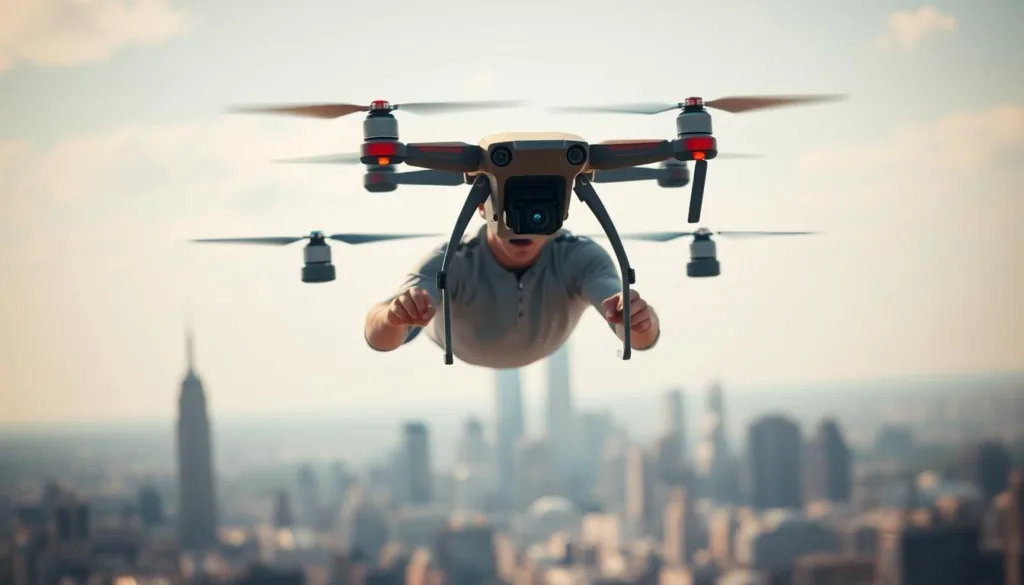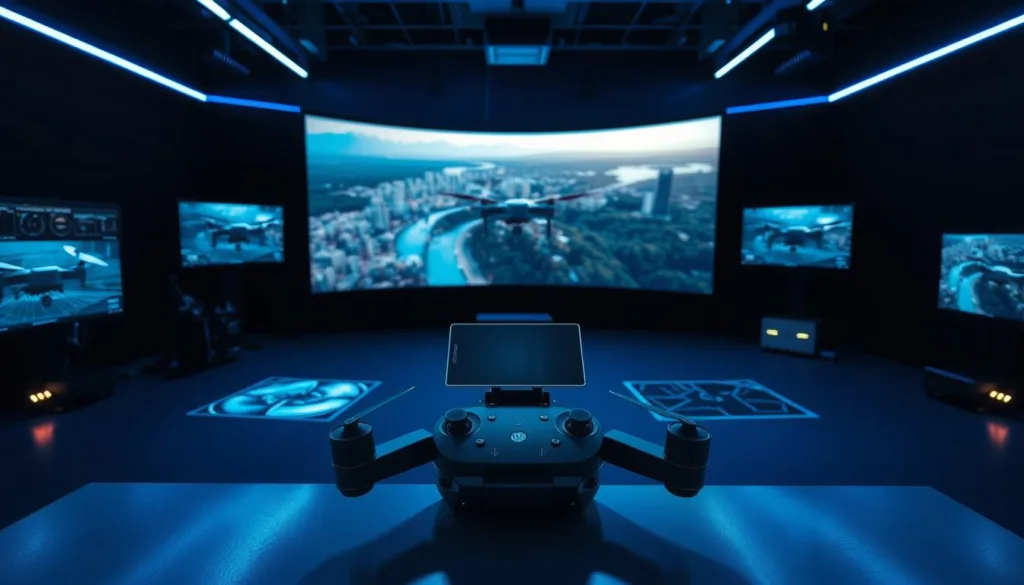Mastering drone piloting skills just got easier. Whether you’re new to aerial technology or looking to refine advanced maneuvers, virtual training tools offer a safe space to learn. These platforms replicate real-world conditions, letting you experiment without risking expensive equipment.
Modern simulation software works seamlessly with popular drone models, including those from leading brands. This compatibility ensures your practice sessions feel authentic. You’ll experience accurate flight dynamics, weather variations, and terrain challenges—all from your computer.
With official software updates ending soon, many pilots are turning to trusted third-party solutions. These platforms continue to support the latest hardware, providing uninterrupted training opportunities. They’re perfect for mastering specialized tasks like agricultural spraying or cinematic filming.
Virtual training isn’t just about avoiding crashes. It’s a cost-effective way to build muscle memory and confidence. You can repeat tricky movements until they become second nature, preparing you for real-flight scenarios.
Key Takeaways
- Virtual environments provide risk-free practice for drone pilots at any skill level
- Compatibility with multiple drone models ensures realistic training experiences
- Third-party solutions maintain support as official software phases out updates
- Accurate flight physics help develop precise control skills
- Cost-effective alternative to damaging equipment during learning phases
Introduction to dji rc controller simulator
Virtual environments are revolutionizing the way pilots prepare for real-world drone operations. These platforms use advanced software to mirror the exact feel of handling aerial devices, letting users build confidence before takeoff. “The attention to detail makes you forget you’re not outdoors,” notes one aviation trainer.
High-fidelity 3D models and lifelike terrain create immersive scenarios. Wind patterns, sudden rain, and shifting sunlight test your adaptability. This precision helps master complex maneuvers without costly errors.
Compatibility spans across popular aerial devices, ensuring your practice translates seamlessly to actual flights. The system works smoothly on Windows 10, delivering stable performance even during intense sessions. Whether you’re mapping landscapes or capturing footage, the interface stays intuitive.
New pilots appreciate the gradual learning curve. Seasoned flyers use it to experiment with advanced techniques. Every session strengthens muscle memory, turning tricky moves into second nature.
Dynamic challenges like gusty winds or low-light conditions push your problem-solving skills. You’ll learn to adjust settings on the fly, preparing for unpredictable real-world situations. Best of all? No repair bills—just pure progress.
Benefits of Virtual Flight Training for Drone Pilots
Modern drone training methods are breaking barriers between practice and real-world performance. Pilots gain access to digital environments that mirror physical challenges while eliminating costly risks. This approach helps users sharpen drone flying skills through repetition—no insurance claims required.

Safe Environment for Practice
Virtual platforms let you crash, recover, and try again—all without denting your budget. One flight instructor remarks, “My students attempt risky maneuvers here they’d never try with physical drones first.” Wind shear? Equipment failure? These scenarios become learning opportunities rather than disasters.
Training experience improves through exposure to diverse weather patterns and terrain types. You’ll navigate rainstorms and low-light conditions while mastering throttle control. Each session builds confidence for actual flights.
Skill Development Without Risk
Repeated drills in drone simulators create muscle memory for complex movements. Perfecting figure-eight patterns or emergency landings becomes second nature. Pilots report faster reaction times when transitioning to real devices.
Advanced users test creative camera angles and flight paths that would be impractical outdoors. The freedom to experiment accelerates skill growth, turning theoretical knowledge into instinctive responses. Best part? Zero repair bills while pushing your limits.
Understanding the Role of DJI Flight Simulator and SRIZFLY
The landscape of virtual flight training is shifting dramatically this summer. With official software updates ending in June 2024, pilots need reliable alternatives that keep their skills sharp. Enter SRIZFLY—the only designated drone simulator partner officially recognized by leading manufacturers.
Key Features and Compatibility
This platform delivers authentic flight physics through advanced algorithms. Every tilt, gust, and camera adjustment mirrors real-world conditions. “It feels like flying actual equipment,” shares a commercial operator who switched platforms last month.
Deep compatibility ensures seamless transitions between models. Whether you’re training with enterprise-grade systems or consumer devices, controls remain consistent. Regular software refreshes maintain alignment with new hardware releases.
Transition After Official Updates Cease
June 2024 marks a turning point for virtual training ecosystems. SRIZFLY’s partnership guarantees uninterrupted access to critical updates and features. Early adopters report smoother workflows compared to outdated systems.
The platform future-proofs your investment by supporting next-generation tech as it launches. Training modules adapt to evolving industry standards, letting pilots stay ahead of regulatory changes. No more scrambling when new devices hit the market.
Setting Up and Configuring Your Drone Simulator
Getting your virtual training environment ready requires attention to hardware and software harmony. Proper configuration ensures lifelike responsiveness during practice sessions, whether you’re learning basic hovering or advanced aerial patterns.

Installation Process and System Requirements
Start by checking your computer’s specs against the software needs. For smooth operation, aim for an i7-7700 processor paired with GTX 1080 Ti graphics and 32GB RAM. Budget setups can manage with a G4560 chip and GTX 1050 Ti, though frame rates may dip during complex scenarios.
Storage matters more than you think. Allocate 80GB of free space—preferably on an SSD—to reduce loading times. One user noted, “Switching to solid-state storage cut my launch time by half compared to traditional drives.”
Connecting Your Physical Controller
Linking your hardware to the virtual world is straightforward with tools like DJI Assistant. This software bridges popular aerial devices—from Mavic Pro to Phantom 4 Pro—with the simulation platform. Ensure firmware matches current versions to avoid connectivity hiccups.
Compatibility extends to multiple controller models, including Lightbridge 2 and M600 Pro setups. Test button responsiveness before diving into training modules. A quick calibration check ensures every stick movement translates accurately on-screen.
Learning Fundamental Flight Controls and Basic Maneuvers
Effective drone operation hinges on understanding core movement mechanics. Four essential commands govern every aerial action, forming the building blocks for advanced techniques. Virtual environments let you explore these controls through hands-on repetition.
Throttle, Yaw, Pitch, and Roll Explained
Throttle acts as your altitude manager. Push up to climb smoothly or lower it for gradual descents. Mastering this control keeps your device steady during hovering and precise landings.
Yaw handles rotation like a spinning top. Twist left or right to change direction without moving position. This proves crucial when scanning environments or adjusting camera angles mid-flight.
Pitch determines forward and backward motion. Tilting the nose down accelerates movement, while pulling up slows momentum. Combine with throttle for diagonal flights across virtual landscapes.
Roll enables side-to-side banking. Use it to dodge obstacles or circle points of interest. When paired with yaw, these movements create fluid turns that maintain speed and stability.
Flight training platforms recreate real-world physics, letting you feel how wind resistance affects each command. Repeated practice builds drone flying skills that translate directly to outdoor sessions. One aviation instructor observes, “Students who master these basics progress three times faster than those who skip fundamentals.”
Through structured training experience, you’ll develop instinctive responses to sudden gusts or terrain changes. Start with simple patterns like square circuits before attempting complex maneuvers. Every session strengthens your ability to predict how aerodynamic forces shape flight paths.
Exploring Advanced Flight Techniques and Simulator Customizations
Pilots ready to push their limits find virtual training platforms transform raw skill into polished expertise. These systems let you test boundaries that would risk equipment or safety outdoors. One commercial operator shared, “I perfected night navigation here before attempting it on actual job sites—saved me thousands in potential repairs.”
Complex Maneuver Simulations
Advanced modules challenge users with scenarios requiring split-second decisions. Practice barrel rolls through narrow canyon passes or execute flawless flips above virtual cities. High-speed obstacle courses demand precise throttle control while dodging dynamic weather patterns.
Emergency procedure drills prepare pilots for real-world crises. Simulated engine failures teach controlled descents, while sudden downpours test stabilization skills. These exercises build reflexes that kick in automatically during actual flights.
Custom Control Settings
Tailor your training experience by adjusting every aspect of the virtual environment. Dial up wind speeds to hurricane levels or create low-visibility fog banks. Cinematographers might soften controls for smooth tracking shots, while racers amp up responsiveness for tight turns.
Many platforms let you save custom profiles for different missions. Aerial inspectors could program recurring industrial site routes, while search-and-rescue teams replicate disaster zones. This flexibility makes the tool invaluable across industries.
Fine-tuning stick sensitivity helps match your natural flying style. Reduce yaw acceleration for deliberate rotations or boost pitch rates for aggressive forward motion. These tweaks create seamless transitions between virtual practice and field operations.
Optimizing Performance: System Requirements and Troubleshooting
Smooth virtual training starts with the right tech setup. Matching your hardware to software needs ensures responsive controls and lifelike physics. Let’s break down what works best across different budgets.
Minimum vs. Recommended Specs
Basic systems can manage training with a G4560 processor and GTX 1050 Ti graphics card. These handle calm scenarios at 30 fps—perfect for learning throttle basics. But for storm simulations or complex terrain, aim higher.
Ideal setups use i7 chips paired with GTX 1080 Ti or better. This combo delivers 60+ fps during intense maneuvers. Don’t forget storage: SSDs cut loading times by 50% compared to traditional drives.
Resolving Common Issues
Experiencing lag? Check background apps eating RAM. One user fixed stuttering by closing browser tabs during sessions. Crashes often trace to outdated drivers—update monthly for stability.
Controllers not responding? Recalibrate through your training software first. If buttons still misbehave, try different USB ports. “Switching ports solved my yaw control glitches instantly,” shares a flight instructor.
Regular maintenance keeps your system ready for tomorrow’s challenges. Clean temporary files weekly and monitor storage space. With these tweaks, your virtual training becomes as reliable as blue skies.
FAQ
What are the benefits of virtual flight training?
Virtual training lets pilots practice in a risk-free environment, improving skills like throttle control and obstacle navigation without damaging equipment. It’s ideal for mastering basics or testing advanced maneuvers safely.
Can I use third-party software after official updates end?
Yes! Partner brands like SRIZFLY offer compatible alternatives with similar features. These tools support popular models and ensure continuous access to realistic training scenarios even after June 2024 updates.
How do I connect my remote to the simulation software?
Use a USB-C cable to link your remote to a computer. Install apps like DJI Assistant for driver support, then follow on-screen prompts to sync controls. Ensure firmware is updated for smooth operation.
What system specs are needed for optimal performance?
A Windows 10/11 PC with at least an Intel i5 processor, 8GB RAM, and a dedicated GPU like NVIDIA GTX 1060 works for basic use. For higher frame rates, upgrade to an i7 processor and 16GB RAM.
How does virtual practice translate to real-world flying?
Simulations replicate real physics, weather conditions, and control responsiveness. Mastering yaw, pitch, and roll in software builds muscle memory, making transitions to physical drones seamless and intuitive.
Can I customize control layouts in training apps?
Absolutely! Adjust stick sensitivity, button mapping, and even create preset profiles for different scenarios. Tailoring settings helps match your personal flying style or specific mission requirements.
What troubleshooting steps fix lag or crashes?
Update graphics drivers, close background apps, and lower in-app resolution settings. If issues persist, check cable connections or reinstall the software. Partner platforms often provide dedicated support teams for assistance.



